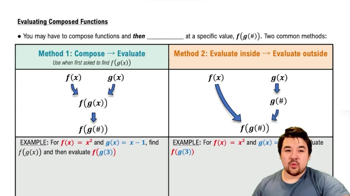Table of contents
- 0. Functions7h 52m
- Introduction to Functions16m
- Piecewise Functions10m
- Properties of Functions9m
- Common Functions1h 8m
- Transformations5m
- Combining Functions27m
- Exponent rules32m
- Exponential Functions28m
- Logarithmic Functions24m
- Properties of Logarithms34m
- Exponential & Logarithmic Equations35m
- Introduction to Trigonometric Functions38m
- Graphs of Trigonometric Functions44m
- Trigonometric Identities47m
- Inverse Trigonometric Functions48m
- 1. Limits and Continuity2h 2m
- 2. Intro to Derivatives1h 33m
- 3. Techniques of Differentiation3h 18m
- 4. Applications of Derivatives2h 38m
- 5. Graphical Applications of Derivatives6h 2m
- 6. Derivatives of Inverse, Exponential, & Logarithmic Functions2h 37m
- 7. Antiderivatives & Indefinite Integrals1h 26m
- 8. Definite Integrals4h 44m
- 9. Graphical Applications of Integrals2h 27m
- 10. Physics Applications of Integrals 2h 22m
4. Applications of Derivatives
Differentials
Problem 53a
Textbook Question
Mean Value Theorem The population of a culture of cells grows according to the function P(t) = 100t / t+1, where t ≥ 0 is measured in weeks.
a. What is the average rate of change in the population over the interval [0, 8]?
 Verified step by step guidance
Verified step by step guidance1
Identify the function given: \( P(t) = \frac{100t}{t+1} \). This represents the population of cells as a function of time \( t \).
The average rate of change of a function \( f(x) \) over an interval \([a, b]\) is given by the formula: \( \frac{f(b) - f(a)}{b - a} \).
Substitute the given interval \([0, 8]\) into the formula. Here, \( a = 0 \) and \( b = 8 \).
Calculate \( P(8) \) by substituting \( t = 8 \) into the function: \( P(8) = \frac{100 \times 8}{8 + 1} \).
Calculate \( P(0) \) by substituting \( t = 0 \) into the function: \( P(0) = \frac{100 \times 0}{0 + 1} \). Then, use these values to find the average rate of change: \( \frac{P(8) - P(0)}{8 - 0} \).
 Verified video answer for a similar problem:
Verified video answer for a similar problem:This video solution was recommended by our tutors as helpful for the problem above
Video duration:
5mPlay a video:
Was this helpful?
Key Concepts
Here are the essential concepts you must grasp in order to answer the question correctly.
Average Rate of Change
The average rate of change of a function over an interval [a, b] is calculated as the difference in the function's values at the endpoints divided by the difference in the input values. Mathematically, it is expressed as (f(b) - f(a)) / (b - a). This concept is crucial for understanding how a function behaves over a specific interval, providing insight into its overall trend.
Recommended video:

Average Value of a Function
Function Evaluation
Function evaluation involves substituting a specific value into a function to determine its output. For the given population function P(t) = 100t / (t + 1), evaluating it at t = 0 and t = 8 will yield the population sizes at these points. This step is essential for calculating the average rate of change over the specified interval.
Recommended video:

Evaluating Composed Functions
Continuous Functions
A continuous function is one that does not have any breaks, jumps, or holes in its graph over its domain. The function P(t) = 100t / (t + 1) is continuous for t ≥ 0, which ensures that the average rate of change can be accurately calculated over the interval [0, 8]. Understanding continuity is important for applying the Mean Value Theorem and other calculus concepts.
Recommended video:

Intro to Continuity







